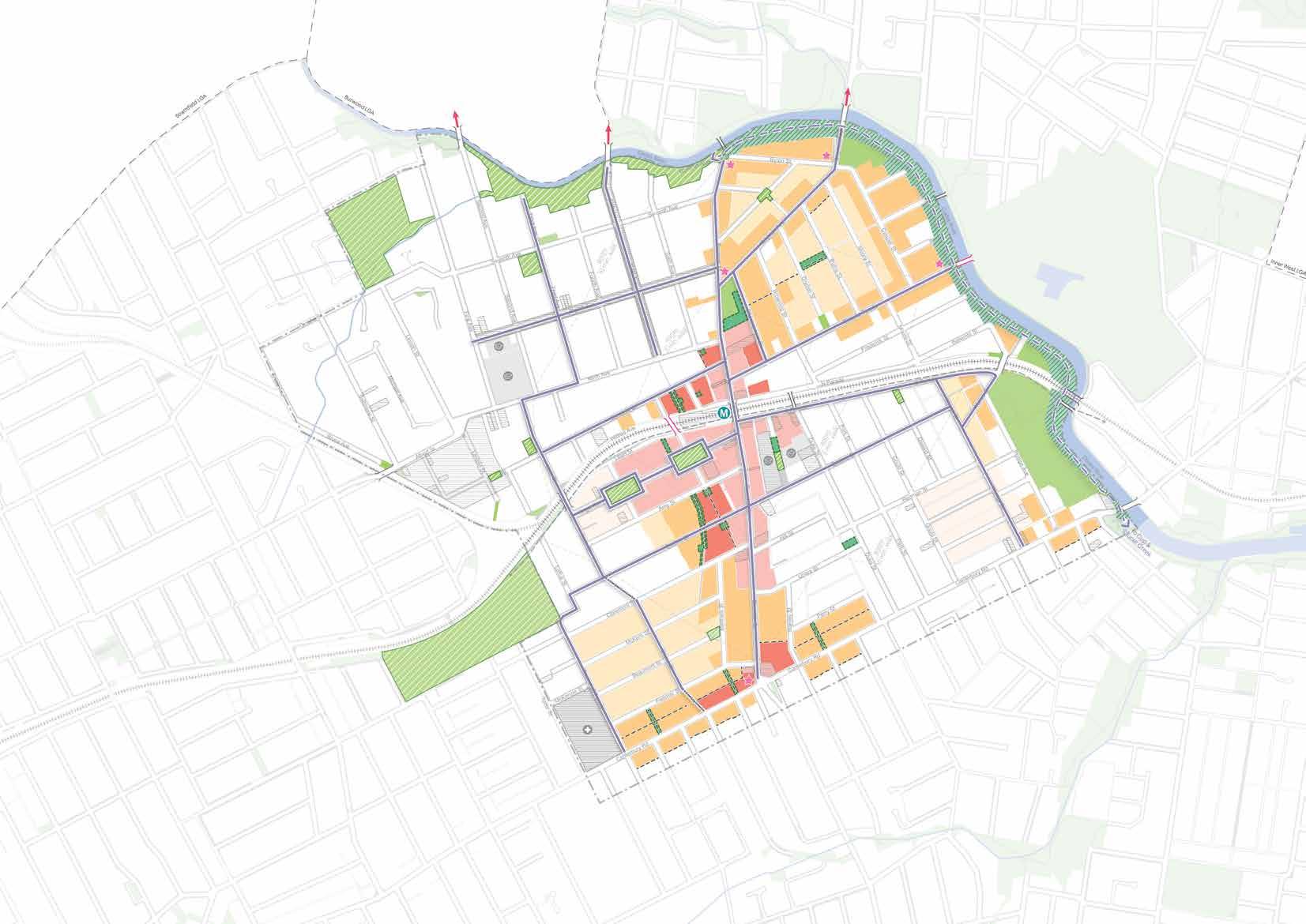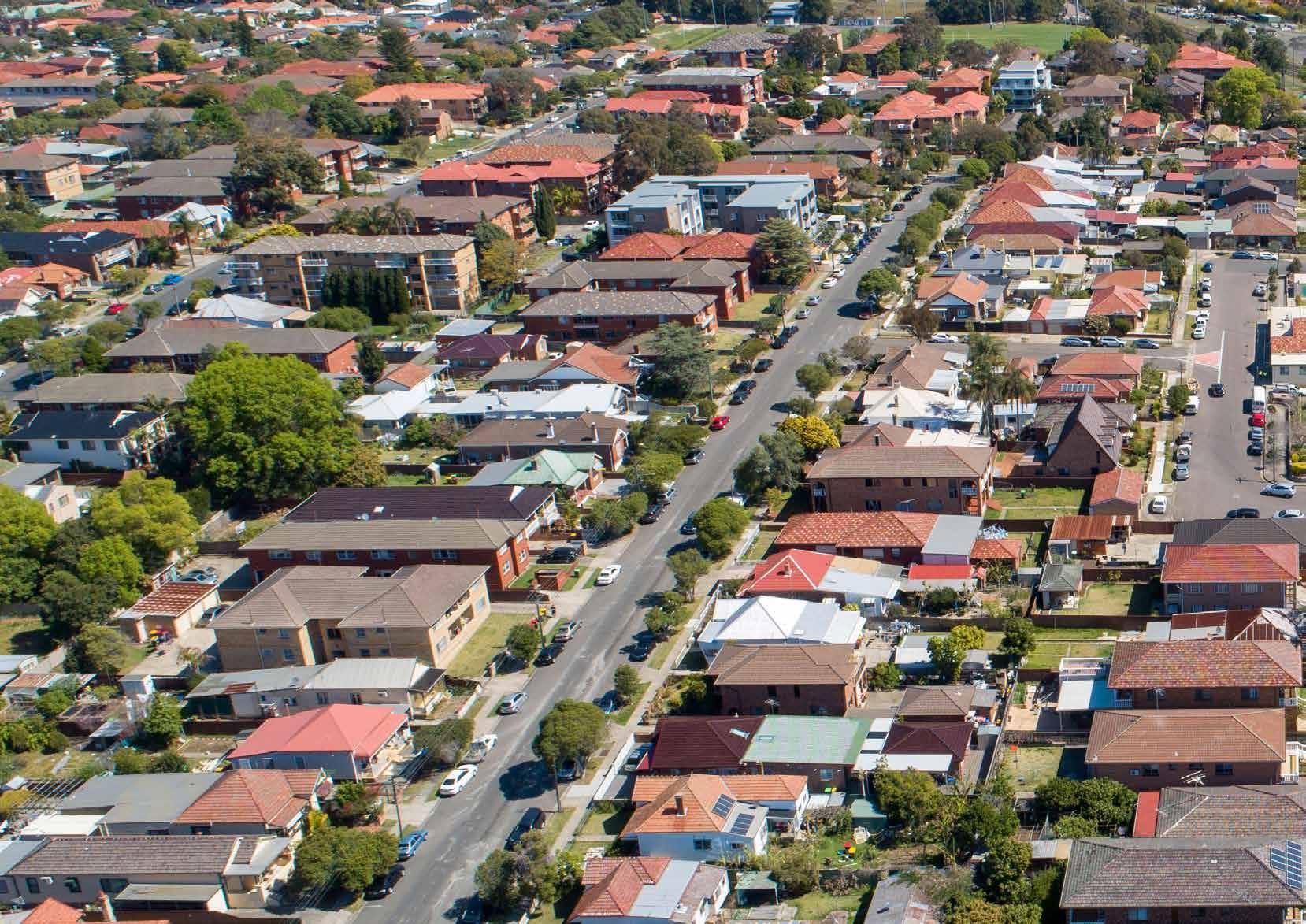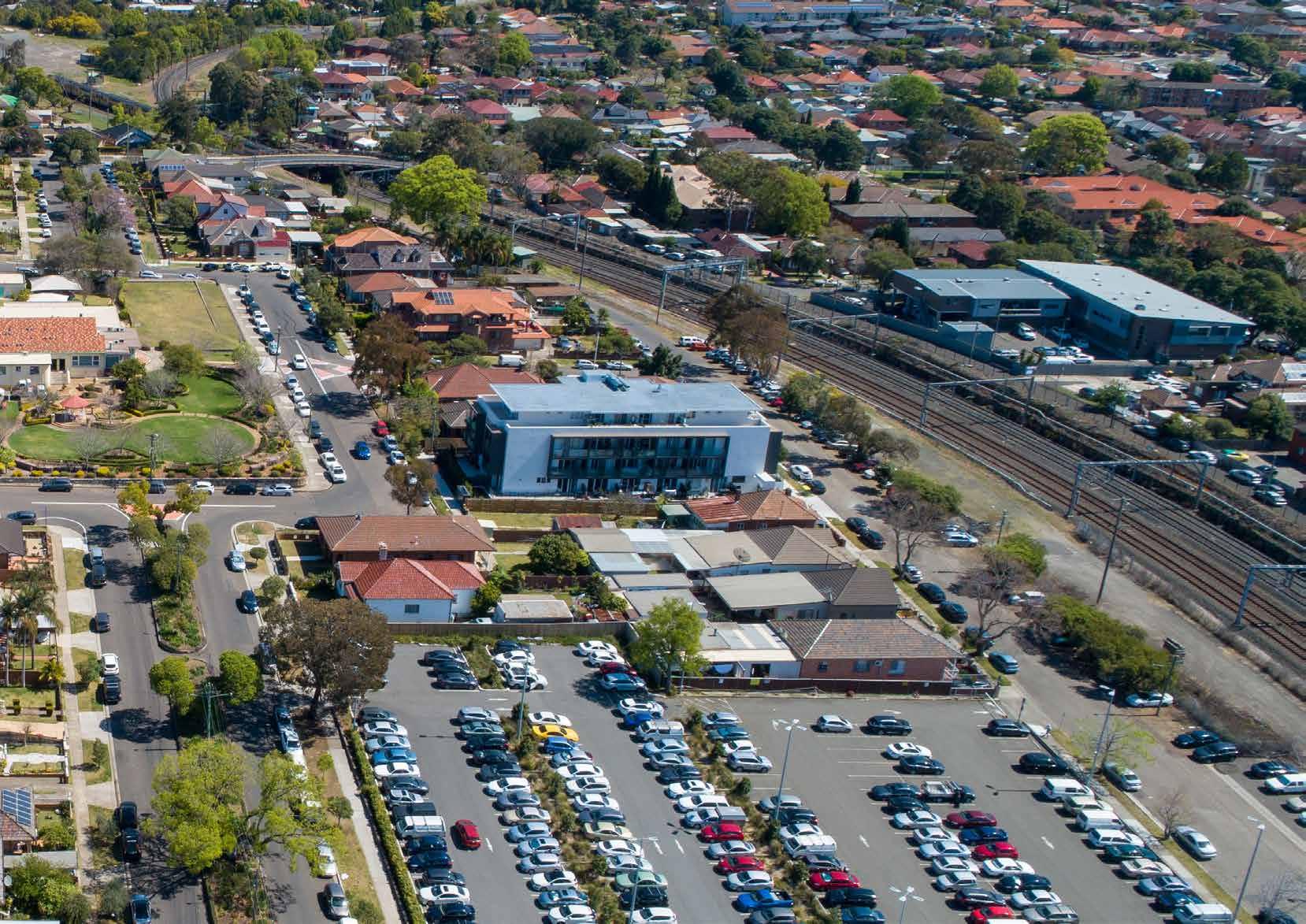
12 minute read
Urban Design Framework Plan
from Draft Campsie Master Plan
by cbcity
2.4 Urban Design Framework Plan
What is an Urban Design Framework?
The Urban Design Framework translates the broad aims of the Local Strategic Planning Statement, Spatial Actions and Intensification Strategy to practical urban design outcomes for Campsie.
The Urban Design Framework Plan underpins and guides urban renewal by promoting new pedestrian and cycle connections, new open spaces and consideration of existing and proposed elements within the built environment. The location of such elements are still considered flexible rather than providing finite solutions.
Why has it been prepared?
The Urban Design Framework Plan illustrates an integrated design vision for the desired future development of the Strategic Centre of Campsie, with the aim to enable communication and testing with stakeholders and the local community. It conveys the physical translation of the Spatial Actions and Intensification Strategy into an Urban Design concept. How is it structured?
The Urban Design Framework for Campsie was prepared with consideration for the following key Urban Design items:
· Connectivity – focuses on movement networks such as roads, pedestrian paths, cycle paths. · Open Spaces – identifies new areas of open space and existing open spaces to be upgraded as part of the Master Plan, as well as key areas of open space dedicated to mitigating flooding and managing stormwater along the Cooks River. · Built Environment – identifies the areas of intensification and the different levels of intensification being considered, as well as key nodes of mixed use within low intensification areas (corner shops) and key heritage items and conservation areas (existing and proposed). This framework plan underpins the 10 Directions of this Master Plan.
Connectivity
The following key items are considered for reinforcing the local connectivity within and surrounding the Campsie Town Centre:
· Proposed Complete Streets; · Cooks River Cycle and Pedestrian Trail. · Pedestrian/Cycle Through Site Links. · Local access and service laneways; and · Bridges and Crossings. Proposed Strategic Streets
The aim of the Master Plan is to promote the establishment of a network of high performing Complete Streets within Campsie. These are walkable and cyclable streets and pathways connecting the key destinations while also performing an enhanced role in terms of Water Sensitive Urban Design and responding efficiently to vehicle movements and parking. This will be further reinforced by the ‘Complete Streets’ initiative for Campsie, being prepared by Council in 2021.
The network of Proposed Complete Streets is formed by:
· Beamish Street connecting Canterbury
Road to the Cooks River. · Brighton Avenue and Clissold Parade connecting the town centre to the
Cooks River foreshore and Canterbury
Racecourse. · Evaline Street and Wonga Street connecting
Belmore Park to Tasker Park. · Anglo Road, surrounding Carrington Park,
ANZAC Park and connecting Belmore Park to the Town Centre. · Loch Street and Orissa Street, following land currently zoned for infrastructure purposes, to establish connections to
Campsie Street, Ninth Avenue and Harcourt
Public School, and potentially providing an alternative connection for through-traffic to move off Beamish Street. · Fifth Avenue and Eighth Avenue, reinforcing the sense of place within the heritage listed avenues. · Campsie Street, connecting the town centre to Loch Street and indirectly to
Belmore Park.
Cooks River Cycle and Pedestrian Trail
A pedestrian and cycle path surrounding Campsie town centre along the southern foreshore of the Cooks River that aligns with open space improvements, and flood mitigation works. This will improve connectivity along the river and to the Canterbury Local Centre and Canterbury Racecourse.
The network of ‘Proposed Complete Streets’ will also consider opportunities for cycleways to connect key open space areas and public infrastructure within Campsie, such as Harcourt Reserve, Rudd Park, Harcourt Public School, Belmore Sports and Recreation Precinct and Tasker Park.
Proposed Local Connections
The Framework Plan proposes a range of local connections in several locations of Campsie.
The aim of these connections is to increase the level of pedestrian and cycle movement permeability throughout the urban fabric, increasing connectivity between key locations such as Campsie Civic Centre and the Cooks River Foreshore, or the existing Woolworths site and the train station, crossing ANZAC Park. These links also provide improved connections to new or existing parks and green spaces.
Service laneways are proposed in areas where vehicle traffic and access to individual development sites is currently constrained. This is relevant particularly for sites fronting to Canterbury Road, where the number of driveways and vehicle entrances to individual sites needs to be avoided for safety reasons.
A new civic and cultural hub
The Urban Design Framework Plan has a new Civic and Cultural Hub at its heart, located at the existing civic precinct. This hub will include an expanded Loft Gardens, adaptive reuse of the Orion Centre, new community civic and cultural facilities included a new and expanded library, multi-purpose facilities and the consolidation of other community facilities from across Campsie. This precinct will also have capacity for institutional and employment-generating development which can support and catalyse growth for Campsie as a Strategic Centre. Bridges and crossings
The Urban Design Framework Plan considers possible upgrades to vehicular bridges on Second Avenue, Burwood Road and Brighton Avenue. Such upgrades are subject to further study, and it is anticipated investment will be derived from the possible enhanced connectivity to Burwood Town Centre. It is proposed the level of upgrade to the selected bridge include consideration of wider pedestrian access and dedicated cycleway. This will allow to maximise direct connectivity between Campsie and Burwood and facilitate a future dedicated public transport connections.
The existing network of pedestrian and cycle bridges crossing the Cooks River is largely proposed to be upgraded or renewed. It is also proposed to establish a new pedestrian and cycling bridge connection extending from Clissold Parade and connecting to Canterbury Racecourse, should this site cease to operate as a racecourse.
Further detail and specific objectives regarding Connectivity in Campsie are provided with Direction 6 – A Centre at the Crossroads of Sydney.
Natural Environment
The following key elements are proposed to increase the provision and quality of open spaces in Campsie.
· Cooks River Foreshore Landscape
Management Area. · Proposed Open Spaces. · Open Spaces to be Upgraded. · Cooks River Foreshore Landscape
Management Area. The Campsie Master Plan proposes the establishment of the Cooks River Foreshore Landscape Management Area, with focus in areas between Canterbury Road and Beamish Street. The aim of this Area is to promote and enhance the amenity along the water edge. This will be achieved by extending the existing mangrove system and riparian corridor along the foreshore, with opportunity to naturalise the river edge and extend from areas further upstream, between Punchbowl Road and Third Ave.
This will allow mitigation of biodiversity degradation and impacts of flooding events along the foreshore of Cooks River, as well as overland flows from the adjacent urban areas. It will also promote and increase the level of public accessibility and connectivity, derived from the Cooks River Foreshore Trail, with opportunities for passive and active recreation along the foreshore and connecting to Canterbury Racecourse.
Proposed Open Spaces
The Urban Design Framework Plan proposes the introduction of a network of neighbourhood, pocket parks and small urban plazas or pedestrian malls, along with the extension of existing open spaces. This is a direct response to the poor public open space network currently servicing Campsie. The main proposed open spaces are: · Expansion of Lofts Gardens with renewal of
Campsie Civic Centre. · Expansion of Harold Street Reserve to the north, approximately doubling in area. · Large development sites within high intensification areas to provide small urban plazas, preferably co-located with Deep
Soil Zones. · Duke Street Pocket Park to be completed. · New neighbourhood park between Dryden
Street and Burns Street.
Open Spaces to be Upgraded
Several of the existing neighbourhood and pocket parks within Campsie are underperforming due to their size and capacity. The Master Plan provides the opportunity to rethink and upgrade some of those parks, particularly in areas of intensification.
Enhancements are also proposed for Regional and District Parks. Further detail and specific objectives regarding Built Environment in Campsie are provided within Direction 5 – A Riverfront Centre with Nature at its Heart.
2.4 Urban Design Framework Plan
Built Environment
The following key elements define the approach to built environment as part of the Campsie Master Plan Urban Design Framework:
· Proposed ‘Corner Shops’. · Areas for intensification. · Heritage items and conservation areas.
Proposed Corner Shops
The Urban Design Framework Plan identifies and proposes a group of sites which due to their location within the urban context, and proximity to key areas of amenity, such as the Cooks River, are considered to provide good conditions for corner shops, including small scale retail and cafe activities. Corner Shops are also proposed at the intersection of Beamish Street and Canterbury Road, in line with Connective City 2036 and Council’s Housing Strategy.
There is also opportunity for improved activation around Tasker Park and the Canterbury Leisure and Aquatic Centre, planned for renewal.
As described previously, the Intensification Strategy was formulated with specific principles applicable to four main areas of Campsie. These are detailed in the following paragraphs. High Intensification Areas
These are the areas where the highest level of intensification is proposed as part of the Master Plan. They are generally within walking distance of the train station and key social infrastructure.
These areas have been identified as the most appropriate location for higher density, and will accommodate buildings with a height above 25 metres. These taller buildings will be subject to carefully developed design controls to ensure they maintain a humanscale at street level and maintain a high standard of amenity for the Town Centre.
A high intensification area is also proposed in the node surrounding Beamish Street and Canterbury Road, supported by the corner shops, previously described.
Medium Intensification Areas (sensitive to heritage and character)
These areas include properties within Campsie which are included in Heritage Conservation Areas Under Investigation, affected to Heritage listed Items or there is a perceived heritage and character value which needs to be carefully considered, such as the areas surrounding ANZAC Park and Carrington Square. Proposed developments in these areas will require best practice in design excellence and consideration of the unique local character. Medium Intensification Areas
Medium Intensification Areas relate to the areas of Campsie where intensification can occur but are outside the immediate core. They include the areas between the Campsie Civic Centre and the Cooks River Foreshore, as well as areas along Canterbury Road, outside the Beamish Street/Canterbury Road, which will form part of the medical precinct.
Low Intensification Areas
Through the analysis, it was identified that these areas can support some intensification by aligning the planning controls (Height and Floor Space Ratio) with other areas of Campsie.
This adjustment is seen as a sensible approach to unlock potential amalgamation of existing single storey housing and promote the development of low-rise apartment buildings which are sympathetic with the existing character in those areas.
Some areas along Tasker Park and Cooks River are also considered within this category due to potential impacts and effects from overland flow and flooding along the Cooks River. Areas of Special Character
These areas include
· Gould Street, Redman Street and Wonga
Street. · Blocks west of Carrington Street. These areas are largely intact, low scale, low density areas on the edges of the Campsie Town Centre. It is proposed that their existing character and built form be retained.
Limited intensification (current Planning controls apply)
In general, areas outside the key intensification areas still allow for some level of intensification to occur under the current planning controls.
Heritage Items and Properties under Investigation for Heritage Significance
Heritage investigations are progressing as part of the Campsie Town Centre Master Plan and Planning Proposal. Preliminary investigations indicate a number of sites be considered as Potential Heritage items and Potential Heritage Conservation Areas. These items will be considered as part of a citywide heritage review.
Further detail and specific objectives regarding Built Environment in Campsie are provided with Direction 4 – A Well Designed Centre and Direction 8 – A Centre Proud of its Heritage and Culture.
Proposed Urban Design Framework
Connectivity Proposed Strategic Streets
East-West Cycle Link (Sydney Metro)
Existing Vehicular Bridges/Underpasses Existing Pedestrian/Cycle Bridges
Proposed Pedestrian/Cycle Bridges
Key links to Burwood Potential New Pedestrian/Cycle Links/Service Laneways Cooks River Foreshore Trail
Open Space Existing Open Spaces Proposed Open Spaces Open Space To Be Upgraded Cooks River Foreshore Landscape Management Area Built Environment
Corner Shops High Intensification Areas Medium Intensification Areas
Medium Intensification Areas (sensitive to heritage and character) Low Intensification Areas
Areas of Special Character Limited Intensification (current planning controls apply)
Existing Hospital + Educational Facilities
Existing Heritage Items (CLEP 2012) and properties under investigation for Heritage Significance Area subject to future investigation and detailed master plan

1:10,000 (A3) 0 100m 200m
3Directions



The Heart of Connective City

Direction 1
A Centre that Aligns Growth with Public Benefit
A Centre that Aligns Growth with Public Benefit
A Resilient and Carbon Neutral City by 2050
A City proud of its Heritage and Culture A City with Housing for All

A Centre that Aligns Growth with Public Direction 2 Benefit A City for People A Centre that Attracts A Well-Designed Direction 3 Health and Lifestyle CentreDirection 4 Investment
A Centre for People A Centre that Attracts Health and Lifestyle Investment A Well-Designed Centre
A City for People A Centre that Attracts A Well-Designed A Riverfront Centre Health and Lifestyle Centre with Nature at its InvestmentA Centre at the A Resilient and A Cent Heartre Proud of its A Centre with Crossroads of Inner Carbon Neutral Heritage and Culture Housing for All Sydney Centre by 2050 A Riverfront Centre with Nature at its Direction 5 Heart
A Riverfront Centre with Nature at its Heart


A Centre at the Direction 6 Crossroads of Inner Sydney A Centre at the Crossroads of Inner Sydney


A Resilient and A CentDirection 7 re Proud of its Carbon Neutral Heritage and Culture Centre by 2050 A Centre with Direction 8 Housing for All
A Resilient and Carbon Neutral Centre by 2050 A Centre Proud of its Heritage and Culture
A Centre with Direction 9 Collaborative and
Transparent
Governance A Centre with
Housing for All










